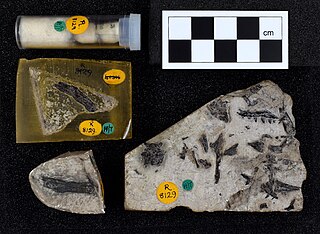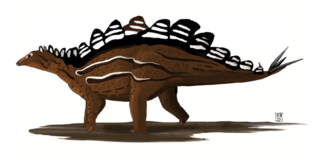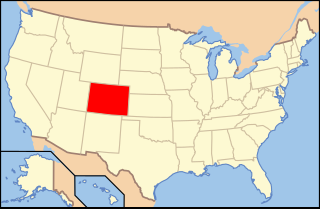Zofiabaatar is a genus of extinct mammal from the Upper Jurassic period. It was a relatively early member of the extinct order Multituberculata within the suborder "Plagiaulacida". It lived in North America along with dinosaurs such as Diplodocus and Allosaurus.

Saurophaganax is a genus of large allosaurid dinosaur from the Morrison Formation of Late Jurassic Oklahoma, United States. Some paleontologists consider it to be a junior synonym and species of Allosaurus. Saurophaganax represents a very large Morrison allosaurid characterized by horizontal laminae at the bases of the dorsal neural spines above the transverse processes, and "meat-chopper" chevrons. It was the largest terrestrial carnivore of North America during the Late Jurassic, reaching 10.5 metres (34 ft) in length and 2.7–3.8 metric tons in body mass.

Brontosaurus is a genus of herbivorous sauropod dinosaur that lived in present-day United States during the Late Jurassic period. It was described by American paleontologist Othniel Charles Marsh in 1879, the type species being dubbed B. excelsus, based on a partial skeleton lacking a skull found in Como Bluff, Wyoming. In subsequent years, two more species of Brontosaurus were named: B. parvus in 1902 and B. yahnahpin in 1994. Brontosaurus lived about 156 to 146 million years ago (mya) during the Kimmeridgian and Tithonian ages in the Morrison Formation of what is now Utah and Wyoming. For decades, the animal was thought to have been a taxonomic synonym of its close relative Apatosaurus, but a 2015 study by Emmanuel Tschopp and colleagues found it to be distinct. It has seen widespread representation in popular culture, being the archetypal "long-necked" dinosaur in general media.
Rhadinosteus parvus is an extinct species of prehistoric frogs that lived during the Late Jurassic. Fossils of the species were found at the Rainbow Park site in Utah's Dinosaur National Monument, from several slabs of rock which contain multiple partial specimens, from sediments belonging to the Morrison Formation. R. parvus was likely a member of Pipoidea and may have been a member of the family Rhinophrynidae.

The Morrison Formation is a distinctive sequence of Late Jurassic sedimentary rock that is found in the western United States, which has a wide assortment of taxa represented in its fossil record, including dinosaur fossils in North America. It is composed of mudstone, sandstone, siltstone and limestone and is light grey, greenish gray, or red. Most of the fossils occur in the green siltstone beds and lower sandstones, relics of the rivers and floodplains of the Jurassic period.
Amphidon is an extinct genus of Late Jurassic mammal from the Morrison Formation. It is present in stratigraphic zone 5. Two species have been named in the genus: Amphidon superstes and Amphidon aequicrurius, by Simpson in 1925.
Aploconodon is an extinct genus of Late Jurassic mammals belonging to the family Amphidontidae. It contains one species, A. comoensis.
Amblotherium is an extinct genus of Late Jurassic and Early Cretaceous mammal. The type species Amblotherium pusillum is from the Lulworth Formation of southern England, while the referred species Amblotherium gracile is from stratigraphic zones 2, 3 and 5 of the Morrison Formation of the US.

Paurodon is an extinct genus of Late Jurassic mammal from the Morrison Formation of the Western United States.
Tathiodon is an extinct genus of Late Jurassic mammal from the Morrison Formation. Present in stratigraphic zone 5.

Dryolestes is an extinct genus of Late Jurassic mammal from the Morrison Formation and the Alcobaça Formation of Portugal. The type species Dryolestes priscus is present in stratigraphic zones 2, 5, and 6.
Euthlastus is an extinct genus of Late Jurassic mammal from the Morrison Formation. Present in stratigraphic zones 5 and 6. It is represented by only five upper molars.
Schillerosaurus was a genus of prehistoric lizard of the Late Jurassic Morrison Formation of Western North America, and is currently the only squamate genus known to be endemic to the Morrison Formation. Described based on a partial skeleton from Dinosaur National Monument by Susan Evans and Dan Chure in 1999 as Schilleria utahensis, its name was subsequently changed to Schillerosaurus due to the former name already being occupied by a modern-day arachnid subgenus.
Saurillodon is a genus of prehistoric lizard of the Late Jurassic of Portugal, UK and Morrison Formation of Western North America.

Dorsetisaurus is a genus of extinct lizard, known from the Late Jurassic of North America, and the Late Jurassic-earliest Cretaceous of Europe. The genus was first reported from the Early Cretaceous (Berriasian) Lulworth Formation of the Purbeck Group of Durlston Bay, in Dorset. It has also been reported from the Late Jurassic aged Alcobaça Formation of Portugal, the Aptian-Albian Dzunbain Formation of Mongolia, and the Morrison Formation of Western North America present in stratigraphic zones 2, 4, and 5. It is considered the oldest widely accepted member of Anguimorpha. based on the presence of 11 shared synapomorphies.

Stegopodus is an ichnogenus erected in 1998 for the second set of stegosaur tracks from the Morrison Formation. The tracks were found near Arches National Park, also in Utah. Unlike the first, this trackway preserved traces of the forefeet. Fossil remains indicate that stegosaurs have five digits on the forefeet and three weight-bearing digits on the hind feet. From this, paleontologists were able to successfully predict the appearance of stegosaur tracks in 1990, six years in advance of the first actual discovery of Morrison stegosaur tracks. Since the erection of Stegopodus, more trackways have been found, however none have preserved traces of the front feet, and stegosaur traces remain rare.
Preprismatoolithus is a Late Jurassic oogenus. The species P. coloradensis is described by John Foster as being "of the prismatic basic type," with subspherical eggs about 10 cm (4 inches) in diameter. This oospecies has been initially attributed to "hypsilophodontid" dinosaurs, although a lack of associated embryo material currently makes confirming the egg-layer's identity impossible, but now is known to be theropod after the finding in Portugal, associated with the embryos.

Paleontology in Colorado refers to paleontological research occurring within or conducted by people from the U.S. state of Colorado. The geologic column of Colorado spans about one third of Earth's history. Fossils can be found almost everywhere in the state but are not evenly distributed among all the ages of the state's rocks. During the early Paleozoic, Colorado was covered by a warm shallow sea that would come to be home to creatures like brachiopods, conodonts, ostracoderms, sharks and trilobites. This sea withdrew from the state between the Silurian and early Devonian leaving a gap in the local rock record. It returned during the Carboniferous. Areas of the state not submerged were richly vegetated and inhabited by amphibians that left behind footprints that would later fossilize. During the Permian, the sea withdrew and alluvial fans and sand dunes spread across the state. Many trace fossils are known from these deposits.

Paleontology in Utah refers to paleontological research occurring within or conducted by people from the U.S. state of Utah. Utah has a rich fossil record spanning almost all of the geologic column. During the Precambrian, the area of northeastern Utah now occupied by the Uinta Mountains was a shallow sea which was home to simple microorganisms. During the early Paleozoic Utah was still largely covered in seawater. The state's Paleozoic seas would come to be home to creatures like brachiopods, fishes, and trilobites. During the Permian the state came to resemble the Sahara desert and was home to amphibians, early relatives of mammals, and reptiles. During the Triassic about half of the state was covered by a sea home to creatures like the cephalopod Meekoceras, while dinosaurs whose footprints would later fossilize roamed the forests on land. Sand dunes returned during the Early Jurassic. During the Cretaceous the state was covered by the sea for the last time. The sea gave way to a complex of lakes during the Cenozoic era. Later, these lakes dissipated and the state was home to short-faced bears, bison, musk oxen, saber teeth, and giant ground sloths. Local Native Americans devised myths to explain fossils. Formally trained scientists have been aware of local fossils since at least the late 19th century. Major local finds include the bonebeds of Dinosaur National Monument. The Jurassic dinosaur Allosaurus fragilis is the Utah state fossil.
















